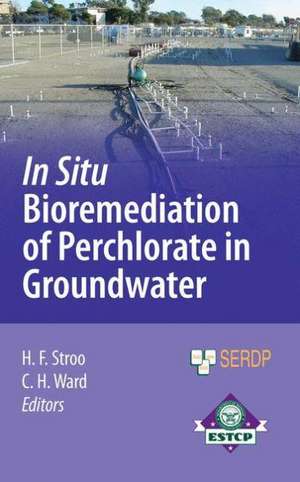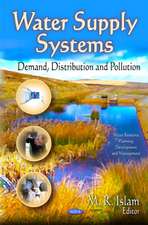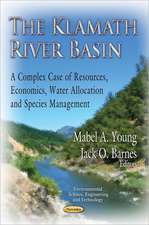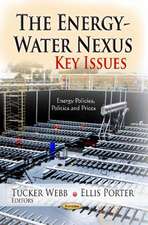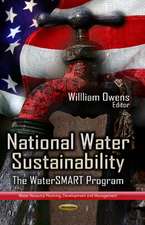In Situ Bioremediation of Perchlorate in Groundwater: SERDP ESTCP Environmental Remediation Technology
Editat de Hans F. Stroo, C. Herb Warden Limba Engleză Paperback – 21 sep 2011
| Toate formatele și edițiile | Preț | Express |
|---|---|---|
| Paperback (1) | 392.37 lei 6-8 săpt. | |
| Springer – 21 sep 2011 | 392.37 lei 6-8 săpt. | |
| Hardback (1) | 406.05 lei 6-8 săpt. | |
| Springer – 2 dec 2008 | 406.05 lei 6-8 săpt. |
Preț: 392.37 lei
Nou
Puncte Express: 589
Preț estimativ în valută:
75.09€ • 81.54$ • 63.07£
75.09€ • 81.54$ • 63.07£
Carte tipărită la comandă
Livrare economică 22 aprilie-06 mai
Preluare comenzi: 021 569.72.76
Specificații
ISBN-13: 9781441927460
ISBN-10: 1441927468
Pagini: 296
Ilustrații: XLVI, 248 p.
Dimensiuni: 193 x 260 x 16 mm
Greutate: 0.52 kg
Ediția:2009
Editura: Springer
Colecția Springer
Seria SERDP ESTCP Environmental Remediation Technology
Locul publicării:New York, NY, United States
ISBN-10: 1441927468
Pagini: 296
Ilustrații: XLVI, 248 p.
Dimensiuni: 193 x 260 x 16 mm
Greutate: 0.52 kg
Ediția:2009
Editura: Springer
Colecția Springer
Seria SERDP ESTCP Environmental Remediation Technology
Locul publicării:New York, NY, United States
Public țintă
Professional/practitionerCuprins
In Situ Bioremediation Of Perchlorate In Groundwater: An Overview.- Development Of In Situ Bioremediation Technologies For Perchlorate.- Principles of Perchlorate Treatment.- Perchlorate Sources, Source Identification And Analytical Methods.- Alternatives For In Situ Bioremediation Of Perchlorate.- Active Bioremediation.- Semi-Passive In Situ Bioremediation.- Passive Bioremediation of Perchlorate Using Emulsified Edible Oils.- Permeable Organic Biowalls for Remediation Of Perchlorate in Groundwater.- Cost Analysis Of In Situ Perchlorate Bioremediation Technologies.- Emerging Technologies for Perchlorate Bioremediation.
Recenzii
From the reviews:
"In Situ Bioremediation of Perchlorate in Groundwater … provides an excellent overview and copious field-based detail regarding the advantages and limitations of perchlorate bioremediation. … Overall, I found In Situ Bioremediation of Perchlorate in Groundwater to be very readable, thoughtfully organized, and brimming with highly applicable information and case studies." (Michael D. Taraszki, Environmental & Engineering Geoscience, Vol. XV (4), November, 2009)
"In Situ Bioremediation of Perchlorate in Groundwater … provides an excellent overview and copious field-based detail regarding the advantages and limitations of perchlorate bioremediation. … Overall, I found In Situ Bioremediation of Perchlorate in Groundwater to be very readable, thoughtfully organized, and brimming with highly applicable information and case studies." (Michael D. Taraszki, Environmental & Engineering Geoscience, Vol. XV (4), November, 2009)
Notă biografică
H. F. Stroo – Dr. Stroo is a Principal Technical Advisor with HydroGeoLogic, Inc. He has a Ph.D. in Soil Science from Cornell University, and over 20 years of experience in the assessment and remediation of contaminated soil and groundwater. He has provided technical support to SERDP/ESTCP in the development and evaluation of innovative remediation technologies for over 10 years, particularly in the advancement of in situ technologies.
C. H. Ward – Dr. Ward has had a 41-year career in basic and applied research on chemical transport and fate in environmental media and remediation technology development for cleanup of fuel hydrocarbons and chlorinated compounds. He is a science and environmental technology consultant and advisor to government (EPA, DoD, DOE) and industry. He was the Director of the EPA-sponsored National Center for Ground Water Research for 18 years, the Superfund University Training Institute for 8 years, and the DoD-sponsored Advanced Applied (environmental) Technology Development Facility for 7 years. He is the Founding Chair of the Department of Environmental Science and Engineering at Rice University and has published over 200 scientific and technical papers and journal articles and 28 books and monographs on environmental remediation, remediation technology development, and sustainability. Dr. Ward is a registered professional engineer in the state of Texas and a Board Certified Environmental Engineer by the American Academy of Environmental Engineers
C. H. Ward – Dr. Ward has had a 41-year career in basic and applied research on chemical transport and fate in environmental media and remediation technology development for cleanup of fuel hydrocarbons and chlorinated compounds. He is a science and environmental technology consultant and advisor to government (EPA, DoD, DOE) and industry. He was the Director of the EPA-sponsored National Center for Ground Water Research for 18 years, the Superfund University Training Institute for 8 years, and the DoD-sponsored Advanced Applied (environmental) Technology Development Facility for 7 years. He is the Founding Chair of the Department of Environmental Science and Engineering at Rice University and has published over 200 scientific and technical papers and journal articles and 28 books and monographs on environmental remediation, remediation technology development, and sustainability. Dr. Ward is a registered professional engineer in the state of Texas and a Board Certified Environmental Engineer by the American Academy of Environmental Engineers
Textul de pe ultima copertă
This volume presents a critical analysis and timely synthesis of the past decade of intensive research, development, and demonstrations on the in situ bioremediation of perchlorate in groundwater. The intended audiences include the decision makers, practicing engineers and hydrogeologists who will select, design, and operate these remedial systems, as well as researchers seeking to improve the current state-of-the-art. Our hope is that this volume will serve as a useful resource to assist remediation professionals in applying and developing the technology as effectively as possible. An overview of the current state-of-understanding of perchlorate remediation is followed by a discussion of basic principles of microbial and abiotic processes, and of the engineering and implementation issues underlying the technologies described. Characterization of both anthropogenic and natural sources of perchlorate, including isotopic analysis to distinguish between differing sources, precedes discussions of the advantages, performance, and relative costs of applying a range of remedial technologies.
Active, semi-passive, and passive in situ bioremediation are fully described and compared with emphasis on field application. Cost information for each technology, using case studies and analyses of several template sites, covers capital costs, as well as costs for laboratory testing, pilot-scale demonstration, design, system operation, monitoring and maintenance during operations, and demolition and restoration after remediation. In addition, analogous cost data are presented for pump-and-treat systems for each template site to illustrate the potential cost savings associated with the use of alternative approaches.
Emerging technologies such as monitored natural attenuation, phytoremediation, and vadose zone bioremediation are described, and field demonstrations are used to illustrate the current stage of maturity and the potential applicability of theseapproaches for specific situations.
Each chapter in this volume has been thoroughly reviewed for technical content by one or more experts in each subject area covered.
Active, semi-passive, and passive in situ bioremediation are fully described and compared with emphasis on field application. Cost information for each technology, using case studies and analyses of several template sites, covers capital costs, as well as costs for laboratory testing, pilot-scale demonstration, design, system operation, monitoring and maintenance during operations, and demolition and restoration after remediation. In addition, analogous cost data are presented for pump-and-treat systems for each template site to illustrate the potential cost savings associated with the use of alternative approaches.
Emerging technologies such as monitored natural attenuation, phytoremediation, and vadose zone bioremediation are described, and field demonstrations are used to illustrate the current stage of maturity and the potential applicability of theseapproaches for specific situations.
Each chapter in this volume has been thoroughly reviewed for technical content by one or more experts in each subject area covered.
